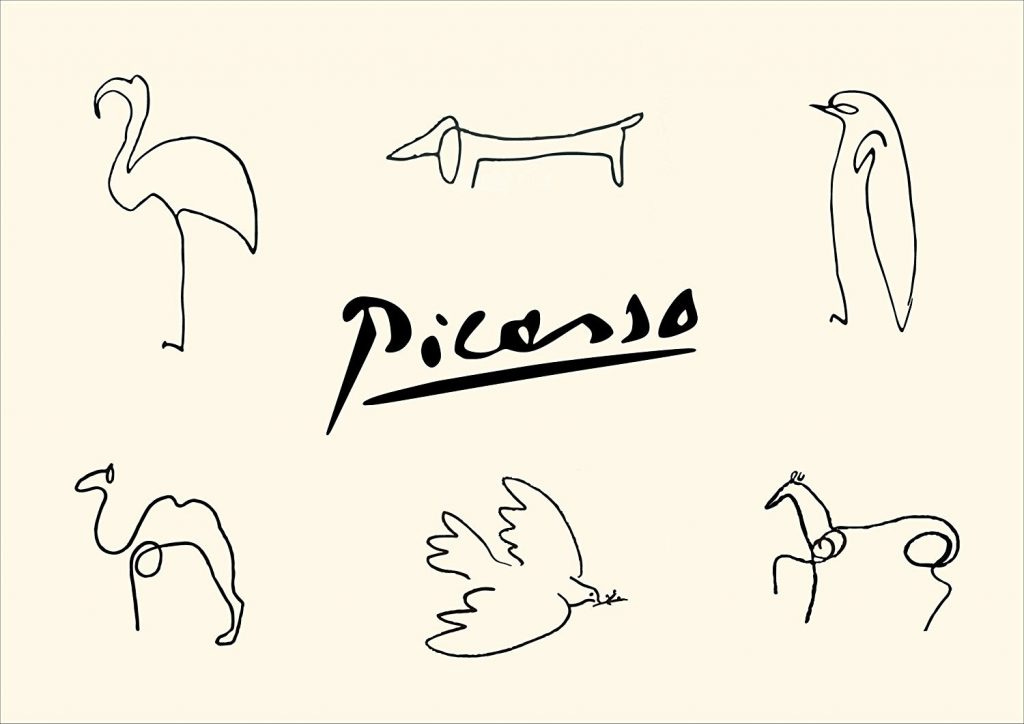Contour & Continuous Line Drawing, An Overview
A history-based approach for sharing the joy of line drawing.
WHAT IS CONTINUOUS LINE DRAWING?
Continuous line drawing is what is sounds like: drawing something without lifting your pencil off the paper!
THE VOCABULARY OF CONTINUOUS LINE:
Contour- the outermost edge of a shape. Think the swish of a ballroom dancer’s gown or the noseline of a portrait drawing.
Line art- just lines in one colour of ink- line art can be dense (like hash marks or lines very close together to make dark areas)- but no colours and no shading.
Blind contour- following the outline of a shape without looking at what you’re drawing.
Gesture- the lines created by the motion of your hand.
WHEN DID CONTINUOUS LINE DRAWING BECOME A THING?
It’s probably something people have always done, but it became popular in the 19th and 20th centuries. With the rise of “modern art” the sketching techniques of artists shifted from precise drafting to more impressionist / idealist simple cartoons.
Painter Pablo Picasso, sculptor Alberti Giacommetti and portraitist Egon Scheile are 3 famous modern artists that employed. We'll look at some of their work today for inspiration.
WHY DO IT?
1: It’s FAST - you can sketch quickly when you’re not wasting time lifting your hand. sometimes as aritists we want to be fast because we’re sketching something that won’t last long (someone speaking in real time for example) or we just need to get a quick idea down for a bigger project later.
2: It’s easily modifiable - don’t like the length of that leg? just scribble it down a little farther.
3: It’s naturalistic - that is, it reflects the gesture of the artist’s hand and with practise can show an individual’s perspective in a concise, flowing way.
Let’s check out some famous continuous-line-drawers!!
PICASSO
Pablo Picasso used continuous line for his elegant individual drawings and also as a fast way to sketch for an idea later. The line sketch allowed him to focus on the core composition while he added colour, texture and pattern to the final piece.
GIACOMMETTI
While an illustrator and painter as well as a sculptor, Alberto Giacommetti is known most for his bronze sculptures. He used continuous line to plan ahead.
EGON SCHEILE
Scheile is a multimedia artist whose large works greatly resemble his sketchbooks. he starts with continuous line and then takes some away for the final.
GIVE IT A TRY?
1 MINUTE EXERCISES
1. Choose and object from the still life to look at and try drawing it for 1 minute without looking at it. Don’t take your charcoal off your paper.
2. Draw the same object for 1 minute in continuous line but look at the object and your drawing while doing it.
3. Compare the images- what stands out? did you do anything differently knowing what you were drawing vs not knowing?
5 MINUTE EXERCISE
Using the first two 1-minute drawings, make a third, allowing yourself to look at the drawings as well as the actual object. Try to add or subtract things you think are important while staying in continuous line as much as you can
STILL LIFE EXERCISE
Look at the entire still life and give it a shot. Take as long or as little time as you like. Here’s mine, after i painted it and traced my lines with india ink:







